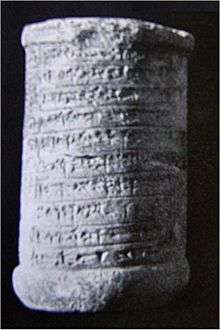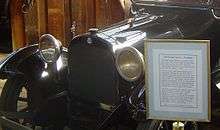Museum label
Pigeon Forge, Tennessee.


A museum label or caption is a label describing an object exhibited in a museum, or one introducing a room or area, or the whole museum.[1][2]
Description of various museum labels
Introduction labels
Kim Kenney, curator of the William McKinley Presidential Library and Museum says that the first label a visitor should see should explain your exhibit display in general. The introduction label should be a “teaser” and talk about the main sections of your exhibit to encourage people to see the rest. If there is something significant or special of the main exhibit, it should be introduced here. At this point the visitor should have a good feeling what the museum is generally about (i.e. museum of Titanic artifacts). Visitors should understand immediately what they are going to see and they should desire to want to see the entire exhibit. Perhaps a brochure would accompany the introduction explaining the main museum, the price, and the hours.[1]
Section labels
A section label is a mini introduction. It consists of sub-topics in a museum exhibition. Kenney says they should represent the "meat" of the museum. If the section is large, perhaps more than one section label is in order. The description should consist of 100-200 words or thereabouts. The visitor should not be strained to read all the labels, so they should be on the short side if anything. In this case "less" is "more" (effective).[1]
Object labels
Object labels are the smallest. They just describe the individual object they are displayed next to. Typically the title of the work or a descriptive title phrase is given, followed by the date and place of creation, and the materials or technique of the object. Increasingly, there may be a brief description or commentary. An accession number is often given, and often the accession date. If the object is included in an audio guide or some other form of tour, there may be a symbol indicating this. Kenney says she prefers in an object label a one word title followed by a 25–50 word description for a museum label. She explains that people want specific aspects of the object they might not notice at first glance or might not have already known (i.e. something unusual, material made of, date of artifact, who made). Most people want to know specifics like when it was made, why it was made, usage and when it became part of the museum.[1]
Credit panel
Practice varies as to whether accession dates and donor information are included. Some donations, especially from government organizations, may specify a credit on the label. Loaned objects are usually specified in some way. It is the opinion of Kenney that donor information clutters up the object label. She believes it is better to give a list of donors on a credit panel.[1]
History
The first known "museum labels" in a museum are from the Ennigaldi-Nanna's museum (a.k.a. Belshalti-nannar museum) originally dating to circa 530BCE.[3][4]
The "museum labels" of the 20th century and 21st century BCE items found in Ennigaldi's museum were labeled in 3 different languages on clay cylinders as to what the centuries old objects were.[5][6][7]
Some of these artifacts were:
- a kudurru, Kassite boundary marker (carved with a snake and emblems of various gods).
- part of a statue of King Shulgi.
- clay cone that was part of a building at Larsa.[4]
Museum-like behavior occurred as early as the 19th-century BCE which gave indications of steps of labeling and cataloging antiquities.[8][9] A "museum label" cylinder tablet describing 100-year-old antiquity objects of circa 2000 BCE read,
| “ | These are copies from bricks found in the ruins of Ur, the work of Bur-Sin of Ur, which while searching for the groundplan (of the temple) the Governor of Ur found, and I saw and wrote out for the marvel of the beholder.[8][10] | ” |
Future

There are studies recently done that demonstrate the feasibility of a wireless Web-based tool for an in-gallery paperless digital label system, perhaps in the form of "Digital Label Towers" or wall mounted digital displays. Some concepts that could be used then is changing configurations of the museum labels, digitally updating the electronic museum label, usability on various display systems, and integrate third party content.[2]
Other advanced digital technology used by some museums is the use of barcodes on their museum labels.[11]
References
| Wikimedia Commons has media related to Museum labels. |

North Carolina Transportation Museum.
- 1 2 3 4 5 Writing Exhibit Labels / object labels
- 1 2 The Enduring Label — How Shall We Label Our Exhibit Today? Applying the Principles of On-Line Publishing to an On-Site Exhibition
- ↑ Woolley, Excavations at Ur: a record of twelve years' work., p. 238 The room was a museum of local antiquities maintained by the princess Belshalti-Nannar, and in the collection was this clay drum, the earliest museum label known...
- 1 2 Casey, p. "First Public Museum" Around 530 B.C.E. in Ur, an educational museum containing a collection of labeled antiquities was founded by Ennigaldi-Nannathe, daughter of Nabonidus, the last king of Babylonia.
- ↑ THE PRECURSORS OF MUSEUMS
- ↑ Leon, p. 36 When archaeologists excavated certain parts of the palace and temple complex at Ur, they were puzzled to find dozens of artifacts, neatly arranged side by side whose ages varied by hundreds of years. Then clay drums with labels in three languages showed up — the first known museum labels.
- ↑ Woolley, Ur of the Chaldees pp. 252–259
- 1 2 Woolley, Excavations at Ur: a record of twelve years' work., p. 236
- ↑ The Role of Museums and the Professional Code of Ethics, p. 1
- ↑ Former Met director—and first-time professor—Philippe de Montebello takes the podium to explain how collectors have anointed “art” through the ages An excavation at the ancient Sumerian city of Ur, in modern-day Iraq, found what is considered the oldest museum label: a 19th-century BCE tablet describing an object, then 100 years old, presented, as it read, “...for the marvel of the beholder.”
- ↑ Running a Museum: A Practical Handbook, p. 30 describes bar codes in "museum labels".
Sources
- Casey, Wilson, Firsts: Origins of Everyday Things That Changed the World, Penguin, 2009, ISBN 1-59257-924-8.
- León, Vicki, Uppity women of ancient times, Conari Press, 1995, ISBN 1-57324-010-9.
- Woolley, Leonard, Ur "of the Chaldees": the final account, Excavations at Ur, Herbert Press, 1982, ISBN 0-906969-21-2.
- Woolley, Leonard, Excavations at Ur — A Record of Twelve Years Work by Sir Leonard Woolley, Ernest Benn Limited, 1955, printed in Great Britain.